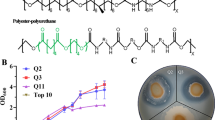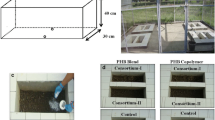Abstract
Thermoplastic-based materials are recalcitrant in nature, which extensive use affect environmental health. Here, we attempt to compare the response of indigenously produced bacterial consortium-I and consortium-II in degrading polyvinyl chloride (PVC). These consortia were developed by using different combination of bacterial strains of Pseudomonas otitidis, Bacillus cereus, and Acanthopleurobacter pedis from waste disposal sites of Northern India after their identification via 16S rDNA sequencing. The progressive degradation of PVC by consortia was examined via scanning electron microscopy, atomic force microscopy, UV–vis, FT-IR spectra, gel permeation chromatography, and differential scanning calorimetry analysis at different incubations and time intervals. The consortium-II was superior over consortium-I in degrading the PVC. Further, the carbon source utilization analysis revealed that the extensive use of consortia has not any effect on functional diversity of native soil microbes.



Similar content being viewed by others
References
Agrawal V, Vishnoi S, Zaidi MGH, Alam S, Rai AK (2010) Synthesis and properties of [60] fullerene-polymethyl methacrylate conjugates in supercritical carbon dioxide. Int J Polym Anal Char 15(5):267–276
Ahmed J, Varshney SK, Zhang JX, Ramaswamy HS (2009) Effect of high pressure treatment on thermal properties of polylactides. J Food Engg 93:308–312
Ali MI, Ahmed S, Robson G, Javed I, Ali N, Atiq N, Hameed A (2014) Isolation and molecular characterization of polyvinyl chloride (PVC) plastic degrading fungal isolates. J Basic Microbiol 54(1):18–27
Anwar MS, Negi H, Zaidi MGH, Gupta S, Goel R (2013) Biodeterioration studies of thermoplastics in nature using indigenous bacterial consortia. Brazilian Arch Biol Technol 56:475–484
Arefian M, Zia M, Tahmourespour A, Bayat M (2013) Polycarbonate biodegradation by isolated molds using clear-zone and atomic force microscopic methods. Int J Environ Sci Technol 10:1319–1324
Barnes DAK, Galgani F, Thompson RC, Barlaz M (2009) Accumulation and fragmentation of plastic debris in global environment. Phil Trans R Soc B 364:1985–1998
Bhattacharyya A, Klapperich CM (2007) Mechanical and chemical analysis of plasma and ultraviolet–ozone surface treatments for thermal bonding of polymeric microfluidic devices. Lab on a Chip 7:876–882
Booth GH, Robb JA (2007) Bacterial degradation of plasticised PVC-effect on some physical properties. Int J Appl Chemi 18:194–197
Campbell CD, Grayston SH, Hirst D (1997) Use of rhizosphere C sources in sole C source tests to discriminate soil microbial communities. J Microbiol Methods 30:33–41
Garland JL (1996) Analytical approaches to the characterization of samples 6 of microbial communities using patterns of potential C source utilization. Soil Biol Biochem 28:213–221
Garland JL, Mills A (1991) Classification and characterization of heterotrophic microbial communities on the basis of patterns of community level sole-carbon-source utilization. Appl Environ Microbiol 57:2351–2359
Holt JG, Krieg NR, Sneath PHA, Staley JT, Williams ST (1994) Gram-positive cocci. In: Hensyl WR (ed) Bergey’s manual of determinative microbiology, 9th edn. Williams and Wilkins, Baltimore, pp 527–558
Kapri A, Zaidi MGH, Goel R (2010) Implications of SPION and NBT nanoparticles upon in-vitro and insitu biodegradation of LDPE film. J Microbiol Biotechnol 20:1032–1041
Kawai F (2010) The biochemistry and molecular biology of xenobiotic polymer degradation by microbes. Biosci Biotechnol Biochem 74:1743–1759
Magan N, Silvia F, Catarina B (2010) Environmental factors and bioremediation of xenobiotics using white rot fungi. Mycobiol 38:238–248
Mishra A, Nautiyal CS (2009) Functional diversity of the microbial community in the rhizopshere of chickpea grown in diesel fuel-spiked soil amended with Trichoderma ressei using sole-carbon-source utilization profiles. World J Microbiol Biotechnol 25:1175–1180
Nakamiya K, Hashimoto S, Ito H, Edmonds JS, Yasuhara A, Morita M (2005) Microbial treatment of bis (2-ethylhexyl) phthalate in polyvinyl chloride with isolated bacteria. J Biosci Bioengg 99:115–119
Patil R, Bagde US (2012) Isolation of polyvinyl chloride degrading bacterial strains from environmental samples using enrichment culture technique. Afr J Biotechnol 11:7947–7956
Ramesh S, Yi LM (2008) FT-IR spectra of plasticized high molecular weight PVC-LiCF3SO3 electrolytes. Ionics 15:413–420
Roy PK, Titus S, Surekha P, Tulsi E, Deshmukh C, Rajagopal C (2008) Degradation of abiotically aged LDPE films containing pro-oxidant by bacterial consortium. Polym Degrad Stab 93:1917–1922
Sah A, Kapri A, Zaidi MGH, Negi H, Goel R (2010) Implications of Fullerene-60 upon in vitro LDPE biodegradation. J Microbiol Biotechnol 20:908–916
Sah A, Negi H, Kapri A, Anwar MS, Goel R (2011) Comparative shelf life and efficacy of LDPE and PVC degrading bacterial consortia under bioformulation. Ekologija 57:55–61
Sandra M, Franchetti M, Egerton TA, White JR (2010) Morphological changes in poly (caprolactone)/poly (vinyl chloride) blends caused by biodegradation. J Polym Environ 18:79–83
Soni R, Kapri A, Zaidi MGH, Goel R (2009) Comparative biodegradation studies of non-poronized and poronized LDPE using indigenous microbial consortium. J Polym Environ 17:233–239
Tribedi P, Sil AK (2013) Low-density polyethylene degradation by Pseudomonas sp. AKS2 biofilm. Environ Sci Pollut Res Int 20:4146–4153
Webb JS, Nixon M, Ian ME, Malcolm G, Geoffrey DR, Pauline SH (2000) Fungal colonization and biodeterioration of plasticized polyvinyl chloride. Appl Environ Microbiol 66:3194–3200
Yadav A, Kumar A, Anupa M (2014) Retrospect and prospect of occupationally induced health hazards for plastic industry workers. Weekly Sci Res J 1:2321–7871
Yang J, Yang Y, Wu W, Zhao J, Jiang L (2014) Evidence of polyethylene biodegradation by bacterial strains from the guts of plastic-eating waxworms. Environ Sci Technol DOI:. doi:10.1021/es504038a
Zeng F, Cui K, Fu J, Sheng G, Yang H (2002) Biodegradation of di(2-ethylhexyl) phthalate by Pseudomonas fluorescens FS1. Water Air Soil Pollut 140:297–305
Acknowledgments
This work is supported by the Department of Biotechnology (DBT) grant to RG. MSA is grateful to Indian Council of Agricultural Research (ICAR), New Delhi for providing financial assistance as a Senior Research Fellow (SRF) during the course of study. The authors are thankful to Dr. Alok Shukla G.B. Pant University of Agriculture and Technology, Pantnagar, Uttarakhand for critical reading and for improving the English language quality.
Conflict of interest
The authors declare that they have no competing interest.
Author information
Authors and Affiliations
Corresponding authors
Additional information
Handling Editor: Peter Nick
All the listed authors have contributed equally.
Rights and permissions
About this article
Cite this article
Anwar, M.S., Kapri, A., Chaudhry, V. et al. Response of indigenously developed bacterial consortia in progressive degradation of polyvinyl chloride. Protoplasma 253, 1023–1032 (2016). https://doi.org/10.1007/s00709-015-0855-9
Received:
Accepted:
Published:
Issue Date:
DOI: https://doi.org/10.1007/s00709-015-0855-9




